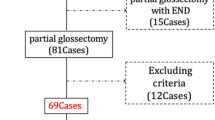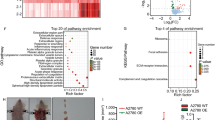Abstract
Ras-related C3 botulinum toxin substrate 1 (rac1) has been implicated in tumor epithelial–mesenchymal transition (EMT); however, limited information is available regarding the role of rac1 in epithelial ovarian cancer (EOC). This study aimed to evaluate the correlation of rac1 expression with EMT and EOC prognosis. Rac1 protein levels of 150 EOC specimens were evaluated by immunohistochemical staining. Survival analysis was performed to determine the correlation between rac1 expression and survival. Cellular and molecular changes were also examined after rac1 in ovarian cancer cells was silenced in vitro and in vivo. The mechanism of rac1 on EMT was investigated by Western blot analysis. Rac1 was highly expressed in EOC. Rac1 overexpression was closely associated with advanced stage based on International Federation of Gynecology and Obstetrics, poor grade, serum Ca-125, and residual tumor size. Survival analyses demonstrated that patients with high rac1 expression levels were more susceptible to early tumor recurrence with very poor prognosis. This study revealed that rac1 downregulation decreased cell EMT and proliferation capability in vitro and in vivo. Rac1 expression possibly altered cell EMT by interacting with p21-activated kinase 1 and p38 mitogen-activated protein kinase signaling pathways. The present study showed that rac1 overexpression is associated with cell EMT and poor EOC prognosis. Rac1 possibly plays an important role in predicting EOC metastasis.




Similar content being viewed by others
References
Jemal A, Siegel R, Xu J, Ward E. Cancer statistics, 2010. CA Cancer J Clin. 2010;50(5):277–300. doi:10.3322/caac.20073.
Ozols RF, Bookman MA, Connolly DC, Daly MB, Godwin AK, Schilder RJ, et al. Focus on epithelial ovarian cancer. Cancer Cell. 2004;5(1):19–24.
Tang L, Yang J, Ng SK, Rodriguez N, Choi PW, Vitonis A, et al. Autoantibody profiling to identify biomarkers of key pathogenic pathways in mucinous ovarian cancer. Eur J Cancer. 2010;46(1):170–9. doi:10.1016/j.ejca.2009.10.003.
Gentry-Maharaj A, Menon U. Screening for ovarian cancer in the general population. Best Pract Res Clin Obstet Gynaecol. 2012;26(2):243–56. doi:10.1016/j.bpobgyn.2011.11.006.
Kohn EC, Hurteau J. Ovarian cancer: making its own rules-again. Cancer. 2013;119(3):474–6. doi:10.1002/cncr.27833.
Jeong GO, Shin SH, Seo EJ, Kwon YW, Heo SC, Kim KH, et al. TAZ mediates lysophosphatidic acid-induced migration and proliferation of epithelial ovarian cancer cells. Cell Physiol Biochem. 2013;32(2):253–63. doi:10.1159/000354434.
Kalra RS, Bapat SA. Expression proteomics predicts loss of RXR-γ during progression of epithelial ovarian cancer. PLoS One. 2013;8(8):e70398. doi:10.1371/journal.pone.0070398.
Zhong YC, Zhang T, Di W, Li WP. Thrombin promotes epithelial ovarian cancer cell invasion by inducing epithelial–mesenchymal transition. J Gynecol Oncol. 2013;24(3):265–72. doi:10.3802/jgo.2013.24.3.265.
Shirkoohi R. Epithelial mesenchymal transition from a natural gestational orchestration to a bizarre cancer disturbance. Cancer Sci. 2013;104(1):28–35. doi:10.1111/cas.12074.
Rodriguez FJ, Lewis-Tuffin LJ, Anastasiadis PZ. E-cadherin’s dark side: possible role in tumor progression. Biochim Biophys Acta. 2012;1826(1):23–31. doi:10.1016/j.bbcan.2012.03.002.
Gallo D, Ferlini C, Scambia G. The epithelial–mesenchymal transition and the estrogen-signaling in ovarian cancer. Curr Drug Targets. 2010;11(4):474–81.
Vergara D, Merlot B, Lucot JP, Collinet P, Vinatier D, Fournier I, et al. Epithelial–mesenchymal transition in ovarian cancer. Cancer Lett. 2010;291(1):59–66.
Hu J, Shao S, Song Y, Zhao J, Dong Y, Gong L, Yang P. Hepatocyte growth factor induces invasion and migration of ovarian cancer cells by decreasing the expression of E-cadherin, beta-catenin, and caveolin-1. Anat Rec (Hoboken). 2010;293:1134–9. doi:10.1016/j.canlet.2009.09.017.
Huang KJ, Sui LH. The relevance and role of vascular endothelial growth factor C, matrix metalloproteinase-2 and E-cadherin in epithelial ovarian cancer. Med Oncol. 2012;29(1):318–23. doi:10.1007/s12032-010-9817-4.
Rathinam R, Berrier A, Alahari SK. Role of Rho GTPases and their regulators in cancer progression. Front Biosci (Landmark Ed). 2011;1(16):2561–71.
Bauer NN, Chen YW, Samant RS, Shevde LA, Fodstad O. Rac1 activity regulates proliferation of aggressive metastatic melanoma. Exp Cell Res. 2007;313(18):3832–9.
Santibáñez JF, Kocić J, Fabra A, Cano A, Quintanilla M. Rac1 modulates TGF-beta1-mediated epithelial cell plasticity and MMP9 production in transformed keratinocytes. FEBS Lett. 2010;584(11):2305–10. doi:10.1016/j.febslet.2010.03.042.
Lv Z, Hu M, Zhen J, Lin J, Wang Q, Wang R. Rac1/PAK1 signaling promotes epithelial–mesenchymal transition of podocytes in vitro via triggering β-catenin transcriptional activity under high glucose conditions. Int J Biochem Cell Biol. 2013;45(2):255–64. doi:10.1016/j.biocel.2012.11.003.
Hage B, Meinel K, Baum I, Giehl K, Menke A. Rac1 activation inhibits E-cadherin-mediated adherens junctions via binding to IQGAP1 in pancreatic carcinoma cells. Cell Commun Signal. 2009;7:23. doi:10.1186/1478-811X-7-23.
Zhang J, Tang L, Shen L, Zhou S, Duan Z, Xiao L, et al. High level of WAVE1 expression is associated with tumor aggressiveness and unfavorable prognosis of epithelial ovarian cancer. Gynecol Oncol. 2012;127(1):223–30. doi:10.1016/j.ygyno.2012.06.008.
Zhou S, Tang L, Wang H, Dai J, Zhang J, Shen L, et al. Overexpression of c-Abl predicts unfavorable outcome in epithelial ovarian cancer. Gynecol Oncol. 2013;131(1):69–76. doi:10.1016/j.ygyno.2013.06.031.
Tahirovic S, Hellal F, Neukirchen D, Hindges R, Garvalov BK, Flynn KC, et al. Rac1 regulates neuronal polarization through the WAVE complex. J Neurosci. 2010;30(20):6930–43. doi:10.1523/JNEUROSCI.5395-09.2010.
Karpushev AV, Levchenko V, Ilatovskaya DV, Pavlov TS, Staruschenko A. Novel role of Rac1/WAVE signaling mechanism in regulation of the epithelial Na+ channel. Hypertension. 2011;57(5):996–1002.
Eden S, Rohatgi R, Podtelejnikov AV, Mann M, Kirschner MW. Mechanism of regulation of WAVE1-induced actin nucleation by Rac1 and Nck. Nature. 2002;418(6899):790–3. doi:10.1161/HYPERTENSIONAHA.110.157784.
Yamazaki D, Oikawa T, Takenawa T. Rac-WAVE-mediated actin reorganization is required for organization and maintenance of cell–cell adhesion. J Cell Sci. 2007;120(Pt 1):86–100.
Sanchez AM, Flamini MI, Fu XD, Mannella P, Giretti MS, Goglia L, et al. Rapid signaling of estrogen to WAVE1 and moesin controls neuronal spine formation via the actin cytoskeleton. Mol Endocrinol. 2009;23(8):1193–202. doi:10.1210/me.2008-0408.
Au CW, Siu MK, Liao X, Wong ES, Ngan HY, Tam KF, et al. Tyrosine kinase B receptor and BDNF expression in ovarian cancers-effect on cell migration, angiogenesis and clinical outcome. Cancer Lett. 2009;281(2):151–61. doi:10.1016/j.canlet.2009.02.025.
Meng Erhong, Taylor Brandon, Ray Anasuya, Shevde LA, Rocconi RP. Targeted inhibition of telomerase activity combined with chemotherapy demonstrates synergy in eliminating ovarian cancer spheroid-forming cells. Gynecol Oncol. 2012;124(3):598–605. doi:10.1016/j.ygyno.2011.11.018.
Kalfa TA, Pushkaran S, Mohandas N, Hartwig JH, Fowler VM, Johnson JF, et al. Rac GTPases regulate the morphology and deformability of the erythrocyte cytoskeleton. Blood. 2006;108(12):3637–45.
Yang WH, Lan HY, Huang CH, Tai SK, Tzeng CH, Kao SY, et al. RAC1 activation mediates Twist1-induced cancer cell migration. Nat Cell Biol. 2012;14(4):366–74. doi:10.1038/ncb2455.
Schnelzer A, Prechtel D, Knaus U, Dehne K, Gerhard M, Graeff H, et al. Rac1 in human breast cancer: overexpression, mutation analysis, and characterization of a new isoform, Rac1b. Oncogene. 2000;19(26):3013–20.
Crnogorac-Jurcevic T, Efthimiou E, Capelli P, Blaveri E, Baron A, Terris B, et al. Gene expression profiles of pancreatic cancer and stromal desmoplasia. Oncogene. 2001;20(50):7437–46.
Vergara D, Merlot B, Lucot JP, Collinet P, Vinatier D, Fournier I, et al. Epithelial–mesenchymal transition in ovarian cancer. Cancer Lett. 2010;291(1):59–66. doi:10.1016/j.canlet.2009.09.017.
Galan Moya EM, Le Guelte A, Gavard J. PAKing up to the endothelium. Cell Signal. 2009;21(12):1727–37. doi:10.1016/j.cellsig.2009.08.006.
Bakin AV, Rinehart C, Tomlinson AK. p38 mitogen-activated protein kinase is required for TGFbeta-mediated fibroblastic transdifferentiation and cell migration. J Cell Sci. 2002;115(pt15):3193–206.
Acknowledgments
The authors thank Lixue Chen and Weixue Tang for their support and technical assistance. The authors also thank Chongqing Key Laboratory of Neurology, The First Affiliated Hospital of Chongqing Medical University, for providing the experimental materials. This study was supported by the National Natural Science Foundation of China (Grant No. 81372800/H1621) and Superior Doctoral Academic Dissertations Research Grant from the Chongqing Medical University.
Conflict of interest
None.
Author information
Authors and Affiliations
Corresponding author
Rights and permissions
About this article
Cite this article
Leng, R., Liao, G., Wang, H. et al. Rac1 expression in epithelial ovarian cancer: effect on cell EMT and clinical outcome. Med Oncol 32, 28 (2015). https://doi.org/10.1007/s12032-014-0329-5
Received:
Accepted:
Published:
DOI: https://doi.org/10.1007/s12032-014-0329-5




